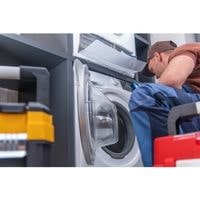Why is my dryer wet inside. The dryer’s exhaust duct may not be properly ventilated, which may lead to condensation inside.
As a result of moisture and lint building up inside the dryer’s exhaust system, it becomes so heavy that it drains back into the drum at the end of the drying cycle.
Why is my dryer wet inside

Your dryer naturally produces hot moist air as moisture combined with wet clothes in the drum.
This moisture exits your dryer through the exhaust system filter, but if there is an obstruction in the duct pipe.
Then this hot moist air doesn’t have a place to go other than out and it would later combine with water infiltration or condensation in the duct which could result in blocked pipes that could lead to a fire.
So you shouldn’t just clean your dryer’s filter regularly, but also check its vent pipe for lint from time to time because it shouldn’t be restricting airflow.
Warm Air Emissions
As hot air combines with wet clothes in the dryer, moisture is naturally produced, but eventually, it filters out of the exhaust system.
An obstruction in the exhaust system, however, can cause moisture to accumulate in the duct and drain back into your dryer.
Periodically cleaning your dryer’s exhaust system can prevent moisture from forming. You should clean the exhaust system in your dryer once every two years and more often if you use it frequently.
Consult the manual for your specific drying machine or purchase an exhaust cleaning kit if you are not sure how to do this.
Also, empty the lint compartment of your dryer once every few loads, if possible, or at the end of each drying cycle.
During any given drying cycle, if the lint compartment is filled with extra lint, it ends up in the ventilation pipe, which could cause a blockage, as it cannot exit via the route that has become clogged.
Then the material used for the duct
One way you can get condensation inside your dryer is by having ductwork that isn’t adequately draining.
If your ducts are made of plastic, they are more susceptible to moisture than metal thus making them an easier target for condensation build-up.
For example, over time plastic ducts may start providing less oxygen flow which in turn may lead to the production of humidity within the said plastic duct.
Whenever this occurs, you’ll want to make sure that you change out your plastic ductwork with one that’s made from a metal material such as aluminum or steel.
We also suggest avoiding using metal wire drums with rough ribs since these will also be a suitable target for moisture since said moisture could easily get trapped within these so-called ‘ribbed areas.
Ducts Aren’t Straight

The dryer may develop a clog in the ductwork if it is kinked.
It is important to examine whether there are any kinks in your duct, as this may result in moisture building up inside the duct and draining into your dryer.
You should be able to identify it by tilting the dryer’s hood toward you so that the hose is accessible.
To remedy any problems, entirely remove existing strains in the hose by either cutting them off or
rearranging their position using aluminum tape rather than screws because screws can trap moisture leading to condensation building up and pooling inside your ducts.
Ducting Takes Too Long
As a dryer is heating and eliminating moisture, this hot air will build up in the duct and cause moisture.
The duct should never be longer than 25 feet or else the moisture will increase within the duct which can result in condensation problems inside the dryer itself as well as health issues for homeowners.
Make sure that when you shorten the length of your vent that you also keep it straight and horizontal so as not to yield any air circulation problems in or around your home or apartment.
Why is my dryer wet inside
Related Guides
